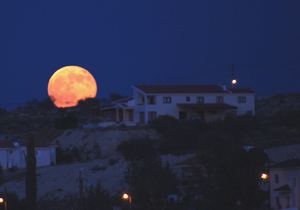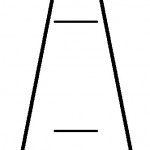 I love illusions, and I love astronomy. So what could be better than combining the two?
I love illusions, and I love astronomy. So what could be better than combining the two?
If you’ve ever seen the Moon rising over the horizon, looking so fat and looming that you felt like you could fall right into it, then you’ve been a victim of the famous Moon Illusion. And it is an illusion, a pervasive and persuasive one.
So, how does this thing work? Ah, step right up.
One of my favorite brain-benders is the Ponzo Illusion. You’ve seen it: the simplest case is with two short horizontal lines, one above the other, between two slanting but near-vertical lines. The upper line looks longer than the lower line, even though they’re the same length.
 The illusion works because our brains are a bit wonky. The slanted lines make us think that anything near the top is farther away; the lines force our brain to think those lines are parallel but receding in the distance (like railroad tracks). The two horizontal lines are physically the same length, but our brain thinks the upper one is farther away. If it’s farther away, then duh, our brain says to itself, it must be bigger than the lower one. So we perceive it that way.
The illusion works because our brains are a bit wonky. The slanted lines make us think that anything near the top is farther away; the lines force our brain to think those lines are parallel but receding in the distance (like railroad tracks). The two horizontal lines are physically the same length, but our brain thinks the upper one is farther away. If it’s farther away, then duh, our brain says to itself, it must be bigger than the lower one. So we perceive it that way.
While procrastinating on reddit, (you do look at reddit, don’t you, especially the science section?) I found this beautiful example of Ponzo:
Heehee! You’d swear up and down* that the red vertical line on the right is much longer than the one on the left, wouldn’t you? It looks almost twice as long to me. It’s a very powerful perception.
 But they’re not! I cut out the two red lines and put them side by side. They’re pretty much exactly the same length (well, they’re off by a bit due to resolution issues in the image, but not by nearly as much as your brain likes to think).
But they’re not! I cut out the two red lines and put them side by side. They’re pretty much exactly the same length (well, they’re off by a bit due to resolution issues in the image, but not by nearly as much as your brain likes to think).
This example is a great one because it uses a real-life image. You can see the wall tiles getting smaller with distance, and the horizontal layout of them, complete with the lines between them, forces your brain to see the line on the right as farther away. Bang! Ponzo.
This illusion plays out all the time… including when the Moon is rising (you were wondering when I’d get back to that, weren’t you?). The Moon Illusion is in part due to this same effect, but weirdly, you also need to understand how we perceive the sky.
If I were to ask you what shape the sky is above your head, you’d probably answer “a hemisphere”. But in fact, almost everyone perceives it as an inverted bowl, flattened at the top. Put it this way: if the sky were a hemisphere above you, you’d say the horizon was as far away as the zenith. But in fact most people perceive the horizon being farther away than the point straight over their heads; test after test has shown this. This isn’t too surprising; think of a cloudy day. The clouds over your head are maybe two or three kilometers above, but near the horizon they may be 100 kilometers away!
See where I’m going with this? When the Moon is on the horizon, your brain thinks it’s far away, much farther than when it’s overhead. So the Ponzo Illusion kicks in: your brain sees the Moon as being huge, and it looks like you could fall into it. The Illusion works for the Sun, too. In fact, years ago I saw Orion rising over a parking lot, and it looked like it was spread across half the sky. It’s an incredibly powerful illusion.
Oddly enough, when it’s on the horizon, the Moon actually is farther away than when it’s overhead. Not by much, really, just a few thousand kilometers (compared to the Moon’s overall distance of about 400,000 kilometers). Behold my Photoshop skillz:
The guy at the top of the Earth in the diagram sees the Moon on his horizon, and the guy on the side of the Earth sees it overhead. But you can tell the distances aren’t the same: the Moon is closer to the guy who sees it as overhead (by an amount roughly equal to the Earth’s radius). That’s no illusion! That’s science, baby.
So the Moon Illusion is just that. It’s not the air acting like a lens, or foreground objects making it look big by comparison. It’s just the way we see the shape of the sky together with the well-known Ponzo Illusion.
Hmmm, is there a metaphor I’m sniffing here? Science taking something we perceive as real, breaking it down, and showing it to be an interesting but decidedly unreal illusion? Well, that’s what science does! It helps us not only understand the world better, but it also makes the world cooler, too.
*Haha! “Up and down!” Haha! Man, I kill me.
Moonrise image from Jorge-11’s Flickr photostream.